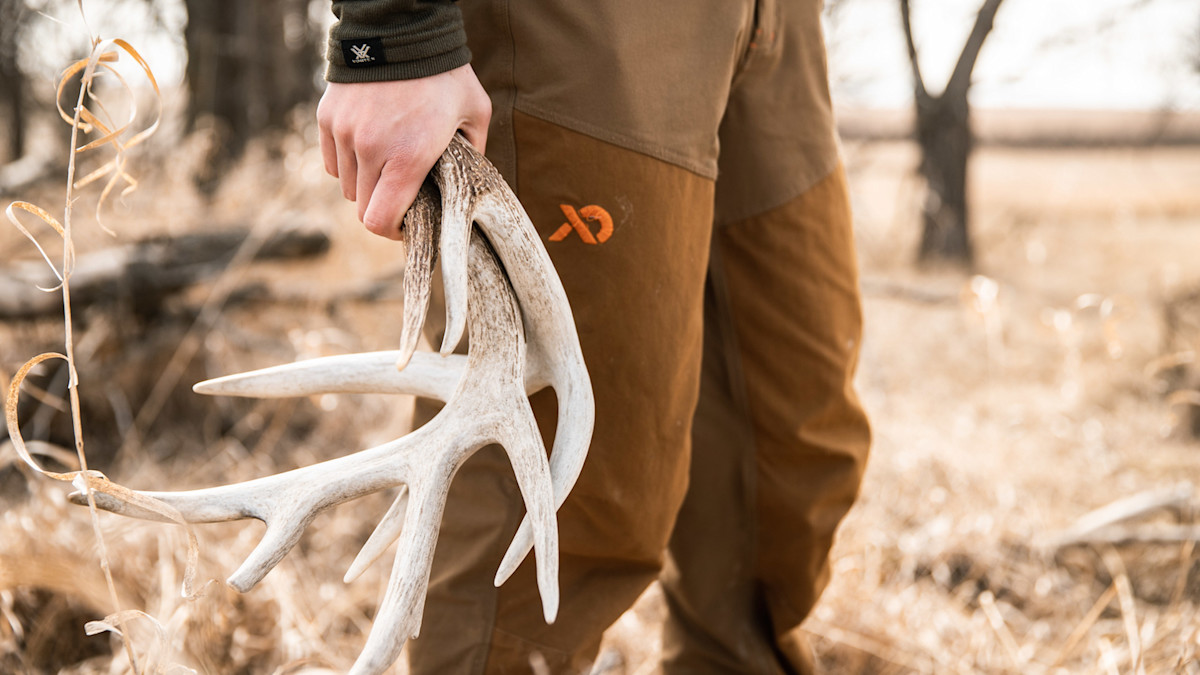
Shane Indrebo, lifelong whitetail fanatic and co-owner of the North American Shed Hunters Club, credits a few simple tactics for finding a whopping 129 sheds last year.
While many shed hunters wait until the spring thaw, Indrebo typically starts searching in January and begins his recon even earlier.
“When I start thinking about shed hunting for the year, I keep an eye out to see where crops have been left for the winter,” Indrebo told MeatEater. “In December, I will check areas to see where there are standing beans, corn, or other winter feed. The deer will winter where there is food. Find where the winter feed is and where the deer are bedding in relation to the food source.”
Indrebo has found fresh sheds as early as mid-December but usually waits another month to begin logging miles in the woods. If he knows a few bruisers are still holding onto their headgear, he pushes that timeline out further.
“If we have big bucks using an area that are still carrying, I will stay out of there until they have dropped,” he said. “Using trail cameras is a major advantage. Knowing that your biggest bucks have dropped helps in knowing when to enter an area so you don’t bump them out before they have dropped.”
He finds the majority of his sheds between mid-February and the end of March but still picks up a few stragglers into April.
His ideal day for shed hunting is overcast with light rain or immediately after a shower. He says such conditions eliminate the shadows that come with harsh light and make spotting sheds a challenge. When the time is right, he focuses on the food sources he scoped out weeks earlier.
“When I begin walking for the year, I start in the crop fields, then work into the areas closely around the food. Pounded areas are very good. My favorite spots are grassy patches or south-facing hillsides where the deer stage before heading into the food,” he said. “I check these areas well then move onto the well-used trails heading to bedding areas. I check flats, clearings, or other areas in the woods that the deer stage before heading into the fields.”
Antlers can be hard to see, so he takes his time and switches up his path to potentially get a better vantage point from a new angle.
“I’ll then grid an area, taking different trails, coming into an area from a different direction, etc.,” he said. “Many times, antlers won’t be visible from one direction, and a lot are missed.”
Public Pay Dirt
Other shed hunters overlooking antlers is exactly what Indrebo counts on, particularly on public land. While it’s best to be “a little quicker on the gun” where competition can be stiff, he says you can still capitalize on the inexperience and laziness of others.
“You need to figure out when the bucks are shedding and try to get in there as soon as you can,” he said. “But don’t get discouraged if you find bootprints or see someone else shed hunting. I have found a lot of sheds near or around human tracks. If need be, go into thicker cover or hard to get to spots. These areas detour a lot of the average shed hunters. Most people will only cover the easy spots and obvious areas. So public land can be very good if you can figure out where to look!”
Gearing Up
Beyond trail cameras that can tell him when bucks have dropped their antlers, Indrebo depends on a few other pieces of gear to improve his shed-hunting odds.
He says solid pairs of hiking boots and rubber boots are essential to keeping feet comfortable while covering hundreds of miles in a few weeks’ time.
And he relies on quality binoculars to help him spot sheds from a distance.
“I glass a lot of sheds from 50 to 100 yards in the woods. It saves a lot of short trips to find a stick or a cornstalk. In fields, I glass sheds up to 500 to 600 yards away, so very good quality glass is important,” he said. “Don’t skimp on binoculars or a spotting scope. Get the best ones that you can afford—they will pay for themselves in no time.”
Regardless of the conditions, he says polarized sunglasses also improve visibility.
“On sunny days or in the snow, they help immensely,” he said. “They also help from getting sticks in the eyes while in the woods! High-quality sunglasses don’t rely on heavy tint, so they are easily worn in the woods and on overcast days.”
And for mapping, Indrebo uses onX to log miles, keep track of which ground he’s covered, and find new areas to search for sheds.
While beating others to the punch, choosing days with optimal conditions, and outfitting yourself for success are important, Indrebo says being a great shed hunter primarily boils down to just finding food and putting boots on the ground.
“The main thing is putting on the miles—a lot of miles. The old saying is ‘miles for piles,’ and it is very true. Last spring, I averaged one antler every 3.5 miles. I picked up 129 sheds and put on over 400 miles doing so,” Indrebo concluded. “If you find where the deer are wintering and put on the miles, you will find the sheds!”
Feature image via Captured Creative.







Conversation